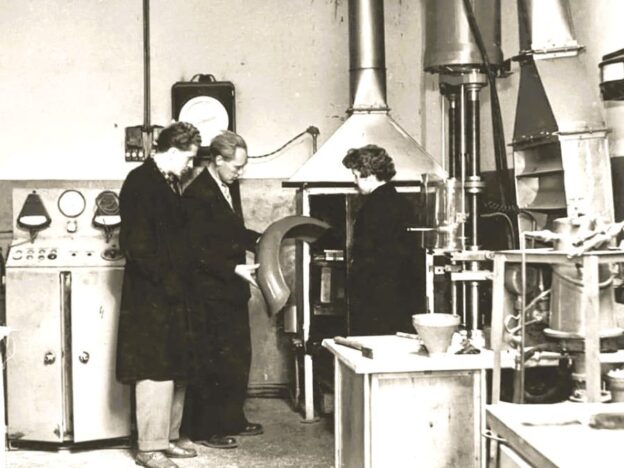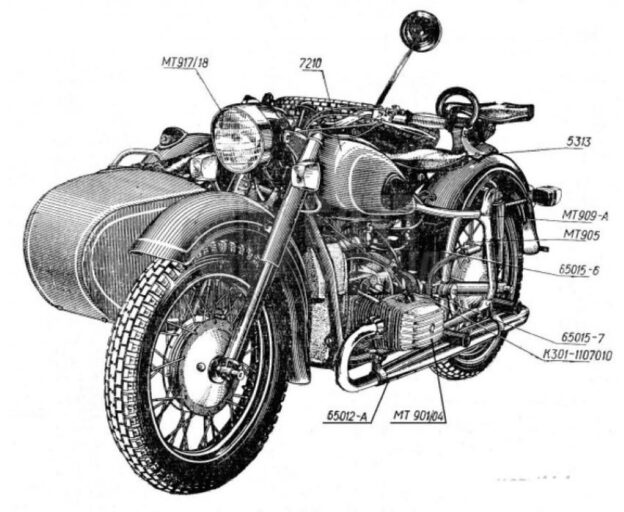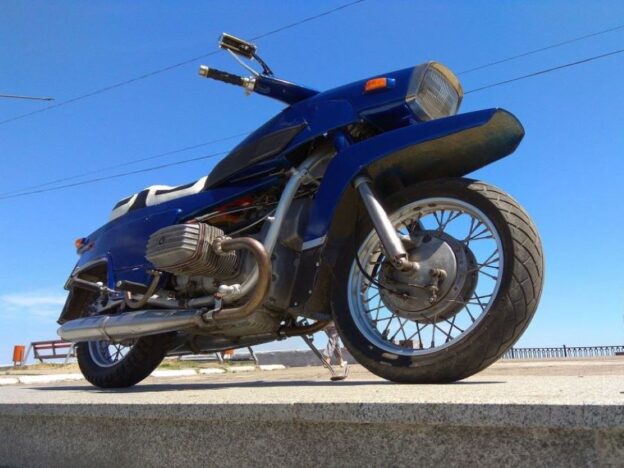features screw on oil filter modification and twin disc front brake
– Dave John



features screw on oil filter modification and twin disc front brake
– Dave John

The Spirit of the Dnepr motorcycles lives on in people’s hearts!

Dnepr MT-9
source: Avtoexport USSR catalogue
Thanks for your fantastic article, tons of interesting information!!!
I’ve been riding motorcycles all my life, from age 14 up until today age 64. It’s in my blood, I’ve riden/owned a variety of makes from Harley to Honda to Triumph as well as many off brands.Finally I have found a Dnepr, at a reasonable price that I plan on making my retirement ride.They are not real popular here in Saskatchewan Canada, so I’m discovering parts are few and expensive. Picked it up last fall, and have started replacing, repairing parts as I find them, but what I really need is information.
Example: I can’t find wheel bearings, I don’t have any type of shop manual, and with out parts numbers local shops and suppliers are of no help. However I will persist, this is probably the last bike project I will take on, and I still have the excitement that I had as a teenager, to complete it. After all, my grandkids are looking forward to sit in the sidecar on the way to the ice cream shop next summer.
Have a great day !!!

An image from KMZ circa 1960 showing quality control inspection of a motorcycle mudguard. The quality of finish must be perfect to pass the quality inspection.

Model MT-9, produced in 1971-1974 a total of 189463 were made.
Quite a bit of time passed since the day the prototype MT-8 motorcycle laid the foundation for the Dnepr K-650 family, and at the end it gave way to its successor, the MT-9, on the conveyor of the Kyiv Motor Plant.
The new “Dnepr” got rid of some of the ailments of its predecessor and acquired in addition a number of valuable qualities. This primarily concerns the power unit – the engine and gearbox. Heavy motorcycle riders know how difficult it can be to turn around in a tight spot or pull a loaded machine out of the mud. For the owners of the MT-9, these procedures are greatly facilitated – its gearbox is equipped with a reversing gear. Another novelty – automatic clutch disengagement when shifting gears – is also used for the first time on heavy motorcycles. By the way, the switching mechanism itself has undergone a reconstruction, thanks to which the reliability and clarity of its operation have significantly increased. The inclusion of a neutral gear is indicated by a sensor and a green lamp located in the headlight.
Other changes aimed at increasing the life of the engine include the introduction of valve caps on the valve stems, bronze bushings in the rocker arms, as well as removable steel racks that prevent wear of the mounting hole of the rocker arm axis when its fastening is loosened, and a more advanced pressure reducing valve, which improved the operation of the system lubricants. It has become double: a ball valve is installed inside the plunger, which bypasses excess oil in cases where the flow area opened by the plunger is not enough.
The new K-301B carburetor provides the motorcycle with higher dynamic and performance qualities. In addition, it is more economical, especially at high speeds, and it is easier to adjust it for the synchronism of the cylinders.
A cast crankshaft with thin-walled white metal “automobile” liners has proven itself well on MT-8 engines. After 40 thousand kilometers, the connecting rod journals of the shaft have practically no wear, so it was used on the MT-9 without change. To improve the ride quality of the motorcycle, the stroke of the rear wheel suspension shock absorbers has been increased, and stepwise adjustment of the “stiffness” of the spring in them is provided. It is pressed depending on the load of the vehicle and the nature of the road. Increased to 150 mm ground clearance allows travel on bad roads and rough terrain.
The MT-9 is equipped with turn signal lights. Design and technological improvements have significantly increased the durability of the motorcycle. The warranty period is now 18 months, and the mileage before major repairs is at least 40 thousand kilometers.
We are confident that the owners who comply with all the requirements of the motorcycle maintenance and operation manual will significantly exceed this figure and will be satisfied with the new MT-9.
В. СВЯТНЕНКО, конструктор
V. SVYATNENKO, designer
Kyiv City
1972N02P12-13
source: bikerwiki.ru

K-750 on KMZ factory test stand “Rolling Road” doing a few kilometers before final issue. c. 1958-1964.

An old scratchy photograph:
K-750 mobile repair shop. Fitted with drive to the sidecar wheel the vehicle had good cross-country capacity and was accessible to difficult worksites. Here it is carrying out repairs to a tracked crane.
photo: Zuev

1959 Kyiv Ukraine…. The factory conveyor belt moves slowly. The frame – the skeleton of the future motorcycle – gradually grows with details. The engine is installed, the handlebars, the wheels, shields are attached. Where the ceremonial tape breaks to workers cheers, there it stands, gleaming with bright blue paint, a finished vehicle with the brand KMZ – Kyiv Motorcycle Plant.
With the release of the new motorcycle K-750, factory workers began the first year of the seven-year plan.
At the plant, they look at everything, many experiments follow. It is difficult to say where this manifests itself more – in the development of new designs or in the improvement of production technology. In any case, the plant has grown in recent years, from lagging behind it to the number one of producing enterprises of the Ukrainian SSR.
In the office of the director of the plant Pavel Fedorovich Nekhoda, there is not quite an ordinary motorcycle – but fitted with a special box instead of the usual passenger sidecar. This new car is called simply a “motorcycle” here.
The motorcycle is designed to provide mobile technical assistance ability in the field to the mechanics and collective farms, as well as for the foremen of tractor brigades. From serial machines, it differs in a special body, where equipment and specialist tools are placed.
The sidecar body is rectangular, welded, has a hinged lid with a bracket for a spare wheel. In the rear part, a locksmith vice is mounted on the lifting workbench-panel. The lid also has a lowering panel to which a box with a set of thread cutting tools is attached. If necessary, the panel is lowered, and it, relying on special body slats, forms a working table on which you can lay out the necessary tools and parts of the repaired mechanism.
In the office of Pavel Fedorovich there is also an album of photographs taken during the prototype testing of a motorcycle in the field.
There is no doubt about the possibilities of this “ambulance motorcycle assistance”. She is not afraid of snow, rain, dirt, and because the drivetrain has a driven on the wheel of the sidecar
The sidecar drive mechanism is a differential with cylindrical gears and a locking device that is turned on and off using lever. This mechanism is the subject of a separate article, Suffice it to say this is an early version of the later developments by KMZ in sidecar drive, which is again a separate topic.
The wheel of the sidecar, as well as all other wheels of the motorcycle, has a lever suspension with spring-hydraulic double-acting shock absorbers, providing high average driving speeds in bad weather conditions.
When visiting the collective farms of Ukraine in 1959, Comrade Premier of the USSR Nikita Khrushchev, himself a native of Ukraine, personally inspected the repair motorcycle and gave it a positive assessment. At the same time, he pointed to the need to create greater convenience for people using this machine, and, in particular, to protect them from the effects of precipitation.
In 1961, two years later, the design of a new all-terrain motorcycle was developed. A mock-up sample of a motorcycle designed for operation in rural areas was made. A five-speed gearbox with reverse is introduced into the design. The first gear would be stronger than in the production boxes, and the motorcycle will be able to easily overcome difficult sections of the road. Fifth gear provides high speed at rated engine speeds.
The motorcycle was equipped with a windshield, deep knee pads, closed footrests. In bad weather, the driver and passenger would be protected by an easily removable canvas awning, a “landau”.
But the promising developments of the Kiev engineers were never given the green light – this motorcycle remained “on the shelf of projects”, as well as many of their counterparts …
In total, at the Kiev Motorcycle Plant in 1958-1959, three prototypes of the mobile workshop and one “modernized” model were made in 1961.
Based on an article by S. Zuev. Using archival materials “Za rulem”, photograph from private and personal collection.

This entry will supplement and enhance known history of the epoch if KMZ for history buffs. JD.
The Kyiv Motorcycle Plant, located in Kyiv, the capital city of Ukraine, one of the oldest cities in Eastern Europe, lies along the Дніпро (Dnipro or Dnieper) River. The plant was established on the basis of the Decree of the Council of People’s Commissars of the USSR No. 2435-652C of 21September 1945 and the order of the People’s Commissar of Medium Machine Building of the USSR No. 362/C of 26 September 1945 on the basis of the former Armored Repair Plant No. 8 in the Shevchenko district of Kiev on Kagatna Street, 8 now Semey Khokhlov Street. The heart of Kyiv.
The Kyiv armored workshops became the basis and base for the creation of the Kiev Motorcycle Plant. In 1932, on the territory and in the production buildings of the plant, where the military workshops of the Kiev Military District were located. From October 1945 to the end of March 1953, the plant was subordinated to the Main Directorate of the Motorcycle and Bicycle Industry (Glavmotoveloprom).
The first model of the two-wheeled motorcycle “Kievlyanin” K-1B, was made with an engine that was produced by war reparations from another enterprise, Wanderer in Germany, but since 1947 the plant began serial production of motorcycles K-1B with an engine of its own production.
Since 1947, the development of a tricycle to assist disabled war veterans began, the company began work on the construction of production shops and structures of the foundry and procurement shops.
In 1949, 100 specialists from the liquidated Gorky Motorcycle Plant (GMZ) arrived at the KMZ plant, where preparations began for the production of heavy class motorcycles M-72, the Soviet version of the German BMW model R71, to supplement production of the M-72 already underway at the IMZ plant in Irbit, Russia.
From the end of March 1953 to the middle of 1953, the KMZ plant was subordinated to the First Main Directorate of the Motorcycle Industry of the Ministry of Mechanical Engineering of the USSR.
According to the Decree of the Presidium of the Supreme Soviet of the USSR of 19 April1954, the Ministry of Automobile and Tractor Agricultural Engineering of the USSR was formed on the basis of the enterprises of the Ministry of Mechanical Engineering of the USSR, to which the Kiev Motorcycle Cycle Plant was subordinated by July 1957.
Since 1956, the plant had developed and began to produce a new, more improved model K-750 and the experimental model M-53. For the period from 1955 to 1970, the production of motorcycles was 45-50 thousand pieces. per year.
In accordance with the Decree of the Council of Ministers of the USSR since 1957 No. 556 and the order of the Ministry of Automobile Industry of the USSR No. 136, on14 June 1957, the plant was transferred to the Department of Machine-Building Industry of the Council of the National Economy of the Kiev Economic Administrative District of the Ukrainian SSR.
On the basis of the Decree of the Kiev Council of National Economy No. 49 of April 1963, the Kiev Motorcycle Plant was transferred from the Department of Machine-Building Industry to the Department of Automobile and Tractor and Agricultural Engineering of the Kiev Council of National Economy.
In accordance with the Decree of the Council of Ministers of the USSR No. 755 of 12 October 1965 , the Kiev Motorcycle Plant was transferred in connection with the liquidation of the Kiev Council of National Economy from the Department of Automobile and Tractor and Agricultural Engineering of the Kiev Council of National Economy for the production of motorcycles and bicycles to the Ministry of Automobile Industry of the USSR.
Since 1972, the production of MODELS MT-9, with a new gearbox (MT-804), with optional reverse.gear was produced,
Since 1976, the improvement of escort equipment began in Kiev, and in 1978 the first batch of 25 special Escort motorcycles for the Kremlin was manufactured. High technical characteristics satisfied the demanding customer. With a capacity of 50hp, on special tires, such a motorcycle could even in winter on a slippery road confidently go at speeds up to 130 km/h and had an electric start, which solved the problem of setting the engine at a temperature of -40C. Such a batch was sent to Moscow in 1983. The Minister of Defense of the USSR Izhmash was instructed to make equipment of this class in Russia. But this attempt was not successful. The great experience and skills of the Kiev designers remained unsurpassed and continued to meet the high requirements of the Kremlin, which increased every year.
In 1989, the last batch of this most advanced technique was manufactured.
In 1991, the first batch of singles of the 650 cm3 class was produced at the Kiev Motor Plant.
Open Joint Stock Company “Kyiv Motorcycle Plant” was founded according to the decision of the Ministry of Mechanical Engineering, Military-Industrial Complex and Conversion of Ukraine No. 1720 of 26 December 1994 in accordance with the Decree of the President of Ukraine No. 210/93 “On corporatization of enterprises” dated 15 June 1993. Registered by the Shevchenkivskyi District State Administration of Kyiv on 12 January 1995, no. 00231314 certificate. At this time, 100% of the shares of JSC “Kyiv Motorcycle Plant” belong to the state represented by the Property Fund of Ukraine.
JSC “Kyiv Motorcycle Plant” is the only enterprise in Ukraine for the production of heavy class motorcycles.
JSC “Kyiv Motorcycle Plant” became a monopoly enterprise of the country for the manufacture of motorcycle equipment. It has a mechanical and assembly production of motorcycles with a complete cycle and contains all the stages for the manufacture and assembly of finished products, control over its quality, transportation at all stages of the production process, organization and provision of maintenance of workplaces and sites, technical preparation of production.
Motorcycles “Dnepr” are constantly being improved, by now there are minimum of 16 modifications of this motorcycle. An upgraded engine, a five-speed gearbox, disc brakes and so on have been developed. New models of motorcycles “Dnepr Chopper”, which are in demand among young people, three-wheeled cargo tricycle “Dnipro – 300” and trike “Dnipro – 303” have been developed. On the basis of a three-wheeled motorcycle with a body, the production of specialized motorcycles for the needs of utilities, trade, farms, forestry, etc. In order to improve the consumer qualities of the motorcycle, the development of new models of the unit with electric start, non-contact ignition system has begun. This will bring the Dnipro motorcycle closer to the requirements of world markets. At this time, the company has mastered the production of new products, namely: trailers for cars of various modifications, van bodies, special vehicles “Convoy-1” and “Van-3”, trailers for the transportation of water equipment.
source: moto032 (translated to English), archives referral
Then the shit hit the fan. The Kiev plant was plunged into doom and darkness. Sold. Closed. Demolished. Gone. The vast sprawling motorcycle plant that had become a legend, only what remains in people’s garages are the memories of this great motorcycle.